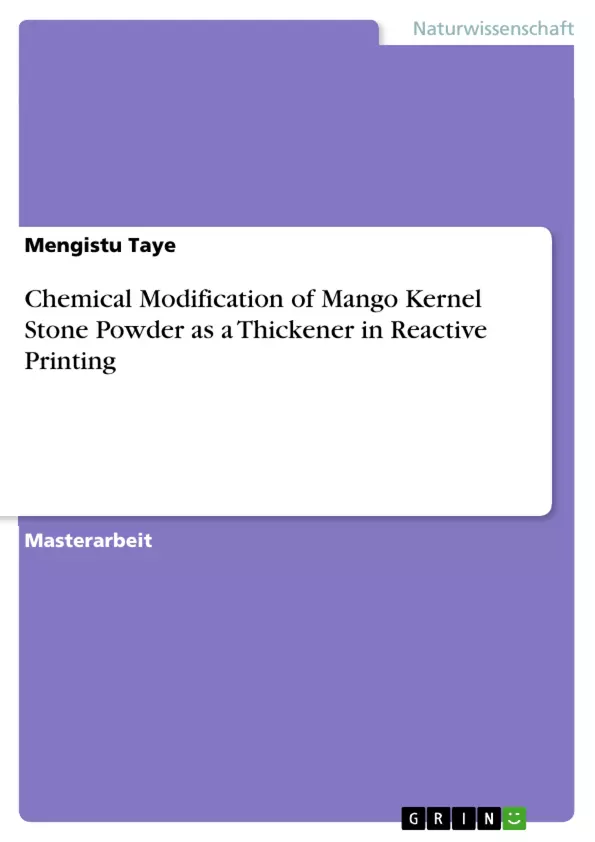In this research Mango kernel stone powder was chemically modified from –OH groups to other groups like -OCOCH3 etc. with the acetic acid and hydrogen peroxide. The aim of this research was to explore the production of chemically modified starch from mango kernel stone powder that can be used mainly in the printing field economically. Hence giving value to mango fruit by product through different routes is not only helps to reduce environmental pollution but also reduces the cost of waste disposal for juice house and processing industries.
In this research Mango kernel stone powder was chemically modified from –OH groups to other groups like acetyl and carboxyl (-OCOCH3) groups. with the acetic acid and hydrogen peroxide.
The aim of this research was to explore the production of chemically modified starch from mango kernel stone powder that can be used mainly in the printing field economically.
Natural thickening agents have better biodegradability and higher compatibility with environment. Hence giving value to mango fruit byproduct through different routes is not only helps to reduce environmental pollution but also reduces the cost of waste disposal for juice house and processing industries.
Keywords: Cotton fabric, Mango, Modification, Thickener, Reactive printing, Characterization
Inhaltsverzeichnis
- ACKNOWLEDGEMENT
- ABSTRACT
- LIST OF TABLES
- LIST OF FIGURES
- LISTS OF ABBREVIATIONS AND ACRONYMS
- CHAPTER 1
- INTRODUCTION
- 1.1 Background and Justification
- 1.2 Problem statement
- 1.3 Objectives
- 1.3.1 General objective
- 1.3.2 Specific objective
- 1.4 Scope of the study
- 1.5 Significance of the study
- 1.6 Benefit and Beneficiaries
- 1.6.1 Benefit
- 1.6.2 Beneficiaries
- CHAPTER 2
- LITERATURE REVIEW
- 2.1 Introduction
- 2.2 Textile Printing
- 2.3 Chemistry of Reactive Dye
- 2.4 Thickeners
- 2.5 Screen Printing
- 2.6 Properties of printing paste
- 2.7 Starch
- 2.8 Mango plant
- 2.9 Literature gap
- CHAPTER 3
- MATERIALS AND METHODS
- 3.1 Materials
- 3.2 Equipment
- 3.3 Chemicals
- 3.4 Methods
- 3.4.1 Experimental Procedure
- 3.4.2 Determining theological properties of powder paste
- CHAPTER 4
- RESULT AND DISCATIONS
- 4.1 Test results of important functional groups
- 4.2 Viscosity result Analysis
- 4.2.1 Unmodified and modified thickener viscosity analysis
- 4.2.2 Viscosity result Analysis for unmodified thickener
- 4.2.3 Viscosity result Analysis for acetic acid modified thickener
- 4.2.4 Viscosity result Analysis for hydrogen peroxide modified thickener
- 4.3 Fastness properties result Analysis
- 4.3.1 Washing fastness
- 4.3.2: Assessment of staining
- 4.3.3 Crock fastness
- 4.4 Color strength result analysis
- 4.4.1 Color strength result analysis for unmodified thickener
- 4.4.2 Color strength result analysis for 3% A.A modified thickener
- 4.4.3 Color strength result analysis for 4% A.A modified thickener
- 4.4.4 Color strength result analysis for 5% A.A modified thickener
- 4.4.5 Color strength result analysis for 3% H2O2 modified thickener
- 4.4.6 Color strength result analysis for 5% H2O2 modified thickeners
- 4.4.7 Color strength result analysis for 7% H2O2 modified thickeners
- 4.5 Whiteness index (WI) analysis (CIE)
- 4.5.1 Whiteness index (WI) analysis for unmodified thickeners
- 4.5.2 Whiteness index analysis for 3% A.A modified thickeners
- 4.5.3 Whiteness index analysis for 4% A.A modified thickeners
- 4.5.4 Whiteness index analysis for 5% A.A modified thickeners
- 4.5.5 Whiteness index analysis for 3% H2O2 modified thickeners
- 4.5.6 Whiteness index analysis for 5% H2O2 modified thickeners
- 4.5.7 Whiteness index analysis for 7% H2O2 modified thickeners
- 4.6: The moisture content of various thickeners
- CHAPTER 5
- CONCLUSION AND RECOMMENDATION
- 5.1 CONCLUSION
Zielsetzung und Themenschwerpunkte
Die vorliegende Arbeit befasst sich mit der chemischen Modifikation von Mangokernsteinpulver als Verdickungsmittel für den Reaktivdruck. Das Ziel ist es, die Druckqualität zu verbessern, indem die Hydrolyse der Reaktivfarbstoffe während des Druckvorgangs reduziert wird.
- Chemische Modifikation von Mangokernsteinpulver
- Verbesserung der Druckqualität durch Reduzierung der Farbstoffhydrolyse
- Einfluss der Modifikation auf die Viskosität, Gelatinisierungstemperatur und andere rheologische Eigenschaften des Verdickungsmittels
- Bewertung der Druckfestigkeit, der Wasch- und Reibechtheit und des Weißheitsindex
- Entwicklung eines nachhaltigen und kostengünstigen Verdickungsmittels für die Textilindustrie
Zusammenfassung der Kapitel
Kapitel 1: Einleitung Dieses Kapitel bietet eine Einführung in das Thema der Arbeit, die den Hintergrund, die Problemstellung, die Ziele und die Bedeutung der Forschungsarbeit erläutert.
Kapitel 2: Literaturübersicht In diesem Kapitel wird die einschlägige Literatur zu Reaktivfarbstoffen, Verdickungsmitteln, Screen-Printing, Eigenschaften von Druckpasten und dem Mango-Baum besprochen.
Kapitel 3: Materialien und Methoden Dieses Kapitel beschreibt die Materialien, Geräte und Chemikalien, die in der Forschungsarbeit verwendet werden. Es werden auch die experimentellen Verfahren und die Methodik zur Bestimmung der rheologischen Eigenschaften der Pulverpaste detailliert erläutert.
Kapitel 4: Ergebnisse und Diskussion Dieses Kapitel präsentiert und diskutiert die Ergebnisse der Experimente. Es werden die Eigenschaften der modifizierten und unmodifizierten Verdickungsmittel untersucht, einschließlich ihrer Viskosität, Gelatinisierungstemperatur und Druckfestigkeit. Darüber hinaus werden die Wasch- und Reibechtheit sowie der Weißheitsindex der bedruckten Stoffe analysiert.
Kapitel 5: Schlussfolgerung und Empfehlung Dieses Kapitel fasst die wichtigsten Erkenntnisse der Forschungsarbeit zusammen und gibt Empfehlungen für zukünftige Forschungsarbeiten.
Schlüsselwörter
Baumwolle, Mango, Modifikation, Verdickungsmittel, Reaktivdruck, Charakterisierung, Farbstoffhydrolyse, Druckqualität, Viskosität, Gelatinisierungstemperatur, Wasch- und Reibechtheit, Weißheitsindex.
- Citation du texte
- Mengistu Taye (Auteur), 2021, Chemical Modification of Mango Kernel Stone Powder as a Thickener in Reactive Printing, Munich, GRIN Verlag, https://www.grin.com/document/1137994



